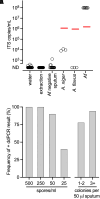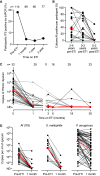Elexacaftor/Tezacaftor/Ivacaftor Markedly Reduces Aspergillus fumigatus in Cystic Fibrosis
- PMID: 39189854
- PMCID: PMC12042367
- DOI: 10.1164/rccm.202406-1128RL
Elexacaftor/Tezacaftor/Ivacaftor Markedly Reduces Aspergillus fumigatus in Cystic Fibrosis
Figures


References
-
- Chesnay A, Bailly É, Cosson L, Flament T, Desoubeaux G. Advent of elexacaftor/tezacaftor/ivacaftor for cystic fibrosis treatment: what consequences on Aspergillus-related diseases? Preliminary insights. J Cyst Fibros . 2022;21:1084–1085. - PubMed
-
- Schaupp L, Addante A, Völler M, Fentker K, Kuppe A, Bardua M, et al. Longitudinal effects of elexacaftor/tezacaftor/ivacaftor on sputum viscoelastic properties, airway infection and inflammation in patients with cystic fibrosis. Eur Respir J . 2023;62:2202153. - PubMed
-
- Morgan S, Cramer R, Vesely E, Ni W, Hong G, Salipante S, et al. Sputum density of Aspergillus fumigatus markedly declines after treatment with elexacaftor-tezacaftor-ivacaftor [abstract] J Cyst Fibros . 2023;22:S34–S35.
Publication types
Grants and funding
LinkOut - more resources
Full Text Sources

